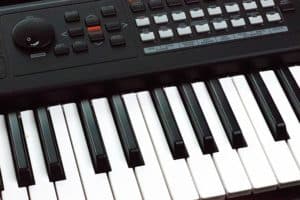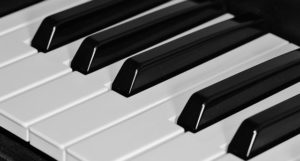Piano notes: they’re probably the first thing you picture when you think about playing, right? But what are they? What’s the difference between piano notes and just any random sound?
It’s a little complicated, but fortunately you don’t need to know too much music theory to understand piano notes and how to use them. And that’s what this video is all about:
What Is a Note?
If you could see sound, it would look like waves. Those waves are what vibrate your eardrums and tell your brain to interpret them as sounds. Depending on how quickly something is vibrating, the pitch of that sound will change.
So simply put, all sounds really are just vibrations. And the most simple explanation of what notes are? Vibrations that sound good while staying consistently at one pitch. So it’s not just a BeeGee’s idea to try and find good vibrations. 😉
If something vibrates fast, it produces a high pitch. But slow vibrations mean lower, deeper sounds. Regardless of how high or low you want your note, maintaining a steady vibration at the right speed is the key to producing a specific note.
No matter what instrument you’re on, steady vibrations are what each note you play is actually made of.
Notes on the Piano
Piano notes run low to high from left to right. If you’ve ever run your fingers across the keys, you can hear the pitch incrementally rising or falling (depending on which direction you’re going).
The inside of your piano is built so that higher notes have a smaller, faster vibration. The lower piano notes have longer, slower vibrations. So moving “up” aka to the right will always mean higher pitch on your piano keys, and vice versa.
How Many Notes?
Although there really is no theoretical limit on what sounds (aka vibrations) could exist, you’ve probably already realized that there isn’t an infinite number of piano notes or musical notes. All instruments have a limit to how much they can vibrate, so that limits what range of notes they can play. That’s a good thing: too many notes would actually not sound nearly as good!
More on Sound Vibrations
One of the many awesome things your brain can do is notice similarities between certain sounds and notes. In fact, unless you’re tone deaf you probably can do a pretty cool thing without even trying: hearing when certain notes are just higher or lower versions of themselves.
If you play any specific note on your piano or keyboard, and then a higher version, they all sound similar. That’s because if you play a low version of that note, you are causing a vibration that is half as fast, or a quarter as fast, or an eight as fast….
When you play a higher version, the vibration is twice as fast, or four times as fast, and so on. This is the math of sound waves: playing different versions of the same note will result in sound waves that are mathematically related to each other. So cool!
 So, how fast do these different notes actually vibrate? It actually shouldn’t matter to you unless you are dabbling in sound tech or related fields. But for example, the center A note on your piano vibrates at 440 times per second, which is called 440 hertz (hz). If you do the math, you’ll see that this means the next A note is vibrating twice as fast. That’s 880 times per second.
So, how fast do these different notes actually vibrate? It actually shouldn’t matter to you unless you are dabbling in sound tech or related fields. But for example, the center A note on your piano vibrates at 440 times per second, which is called 440 hertz (hz). If you do the math, you’ll see that this means the next A note is vibrating twice as fast. That’s 880 times per second.
Like I said, these numbers aren’t really important for our purposes. But I still think it’s pretty cool to find that all vibrations can be so easily divided or multiplied depending on how high or low you go for a given note.
What You Have vs. What You Play
A standard 88-key piano or keyboard has… you guessed it: 88 keys. 😉 Do we usually play them all in a song? No way! Just because you have all these notes does not mean they all sound good together. You probably already knew this, because if you’ve ever hit a wrong note on the piano you felt immediately that something was wrong. Apparently, our brains are pretty good at understanding what notes do or don’t “fit” in certain combinations.
The basis for most of music theory today is the 12 notes that make up the Western music scale. Believe me when I saw that the reasons for this are way outside the scope of this post. You’ll have to do some more research if you want to get deep in those musical theory weeds! It’s simply not necessary for our purposes.
A System of 12 Notes
To successfully learn about and use piano notes, we need to know what they’re called. There are a few notation methods (do-re-mi, numbered notes, etc). But the most popular names for these notes use letters from the alphabet, like the A note in my example about vibrations.
Unfortunately, piano notes do not start at A. They are:
- C, C sharp, D, D sharp, E, F, F sharp, G, G sharp, A, A sharp, B.
We can also write them this way (recommended):
- C, C#, D, D#, E, F, F#, G, G#, A, A#, B.
If you learn these 12 notes, you will know all the piano notes. They simply repeat across your whole instrument. So if you’ve been worrying about memorizing 88 individual keys, worry no more! All you need to know are the 12. 🙂
Steps and Half-Steps (aka Tones and Semitones)
The distance between each piano note is called semitone or a half step. So if you need to play one semitone up or one half step up from A, that’s A sharp (A#). One semitone or half step down from A is G sharp (G#), etc.
The distance between two notes? That’s one tone, or a whole step. So from G to A is a tone or whole step. G to B is two tones, or two whole steps. It may help for you to check these notes on your own instrument to help you understand this.
What About Octaves?
Now for another important topic: octaves. If you learn my piano approach you’ll often be playing octaves in your left hand. What are they? Basically, they’re notes that are identical except in a different set of 12 piano keys. In other words, they’re notes that are half as fast or twice as fast as each other.
If you place a C note at the center of your keys and you move to the next C note by 12 keys, you are moving by one octave. If you moved to the C note after that, you’ve moved two total octaves.
The Difference Between White and Black Notes
 Don’t be alarmed: there is no big difference between white and black piano notes. They could be any color, the only reason they are colored differently is to help you navigate your piano and keyboard while understanding how far apart the different keys are musically.
Don’t be alarmed: there is no big difference between white and black piano notes. They could be any color, the only reason they are colored differently is to help you navigate your piano and keyboard while understanding how far apart the different keys are musically.
The white notes go like this from left to right: C, D, E, F, G, A, B. Those are the seven white notes. They start over from C once you get to B.
Meanwhile, the black notes get their name from the keys they are next to. So black note to the right of C is C sharp (C#), the black note to the right of D is D sharp (D#), and so on.
We can also identify the black notes by which keys they are to the left of. In that case, we call them flats instead of sharps. So the black note to the left of D is D flat (D♭), the black note to the left of E is E flat (E♭), and so on.
Black keys are one semitone (aka half step) up or down from the white key they get their name from.
Wrapping Up
There’s so much more you could learn about the music theory of piano notes – and the science of sound vibrations! But today we’ve covered the basics, what you really need to know. A great way to start learning your piano notes? Check out my free 5-day workbook.

